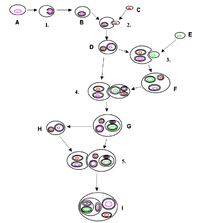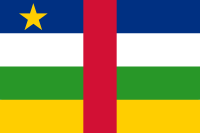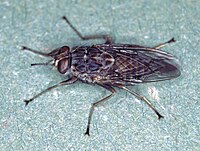
Big Baby, Little Mother: Tsetse Flies Are Exceptions to the Juvenile Small Size Principle
Sign Up to like & getrecommendations! Published in 2020 at "BioEssays"
DOI: 10.1002/bies.202000049
Abstract: While across the animal kingdom offspring are born smaller than their parents, notable exceptions exist. Several dipteran species belonging to the Hippoboscoidea superfamily can produce offspring larger than themselves. In this essay, the blood‐feeding tsetse… read more here.
Keywords: big baby; little mother; baby little; tsetse flies ... See more keywords

Single-cell RNA sequencing of Trypanosoma brucei from tsetse salivary glands unveils metacyclogenesis and identifies potential transmission blocking antigens
Sign Up to like & getrecommendations! Published in 2020 at "Proceedings of the National Academy of Sciences of the United States of America"
DOI: 10.1073/pnas.1914423117
Abstract: Significance African trypanosomes, Trypanosoma brucei spp., are transmitted by the bite of infected tsetse flies. Mammalian vaccines are not available, and diagnosis and treatment remain difficult in the affected remote areas. The transcriptomic analysis of… read more here.
Keywords: metacyclogenesis; tsetse; transmission blocking; cell ... See more keywords

Unravelling the relationship between the tsetse fly and its obligate symbiont Wigglesworthia: transcriptomic and metabolomic landscapes reveal highly integrated physiological networks
Sign Up to like & getrecommendations! Published in 2017 at "Proceedings of the Royal Society B: Biological Sciences"
DOI: 10.1098/rspb.2017.0360
Abstract: Insects with restricted diets rely on obligate microbes to fulfil nutritional requirements essential for biological function. Tsetse flies, vectors of African trypanosome parasites, feed exclusively on vertebrate blood and harbour the obligate endosymbiont Wigglesworthia glossinidia.… read more here.
Keywords: symbiont; relationship tsetse; tsetse fly; unravelling relationship ... See more keywords

Microbe Profile: Wigglesworthia glossinidia: the tsetse fly's significant other.
Sign Up to like & getrecommendations! Published in 2022 at "Microbiology"
DOI: 10.1099/mic.0.001242
Abstract: Wigglesworthia glossinidia is an obligate, maternally transmitted endosymbiont of tsetse flies. The ancient association between these two organisms accounts for many of their unique physiological adaptations. Similar to other obligate mutualists, Wigglesworthia's genome is dramatically… read more here.
Keywords: wigglesworthia; profile wigglesworthia; tsetse; microbe profile ... See more keywords

A machine learning approach to integrating genetic and ecological data in tsetse flies (Glossina pallidipes) for spatially explicit vector control planning
Sign Up to like & getrecommendations! Published in 2021 at "Evolutionary Applications"
DOI: 10.1111/eva.13237
Abstract: Vector control is an effective strategy for reducing vector‐borne disease transmission, but requires knowledge of vector habitat use and dispersal patterns. Our goal was to improve this knowledge for the tsetse species Glossina pallidipes, a… read more here.
Keywords: vector; suitability; vector control; tsetse ... See more keywords

Estimating tsetse fertility: daily averaging versus periodic larviposition
Sign Up to like & getrecommendations! Published in 2019 at "Medical and Veterinary Entomology"
DOI: 10.1111/mve.12399
Abstract: When computing mean daily fertility in adult female tsetse, the common practice of taking the reciprocal of the interlarval period (called averaged fertility) was compared with the method of taking the sum of the products… read more here.
Keywords: tsetse fertility; fertility daily; estimating tsetse; tsetse ... See more keywords

A volatile sex attractant of tsetse flies
Sign Up to like & getrecommendations! Published in 2023 at "Science"
DOI: 10.1126/science.ade1877
Abstract: Tsetse flies transmit trypanosomes—parasites that cause devastating diseases in humans and livestock—across much of sub-Saharan Africa. Chemical communication through volatile pheromones is common among insects; however, it remains unknown if and how such chemical communication… read more here.
Keywords: tsetse; volatile sex; tsetse flies; mpo ... See more keywords

Chemical notes of tsetse fly mating
Sign Up to like & getrecommendations! Published in 2023 at "Science"
DOI: 10.1126/science.adg2817
Abstract: Description Volatile pheromones offer a means to control flies that spread disease As described nearly half a century ago, the tsetse fly lies at the center of a vast and complex biological system extending across… read more here.
Keywords: notes tsetse; tsetse; tsetse flies; tsetse fly ... See more keywords

Combining paratransgenesis with SIT: impact of ionizing radiation on the DNA copy number of Sodalis glossinidius in tsetse flies
Sign Up to like & getrecommendations! Published in 2018 at "BMC Microbiology"
DOI: 10.1186/s12866-018-1283-8
Abstract: BackgroundTsetse flies (Diptera: Glossinidae) are the cyclical vectors of the causative agents of African Trypanosomosis, which has been identified as a neglected tropical disease in both humans and animals in many regions of sub-Saharan Africa.… read more here.
Keywords: paratransgenesis; copy number; number; tsetse ... See more keywords

Molecular characterization of tsetse’s proboscis and its response to Trypanosoma congolense infection
Sign Up to like & getrecommendations! Published in 2017 at "PLoS Neglected Tropical Diseases"
DOI: 10.1371/journal.pntd.0006057
Abstract: Tsetse flies (Glossina spp.) transmit parasitic African trypanosomes (Trypanosoma spp.), including Trypanosoma congolense, which causes animal African trypanosomiasis (AAT). AAT detrimentally affects agricultural activities in sub-Saharan Africa and has negative impacts on the livelihood and… read more here.
Keywords: congolense infection; trypanosoma congolense; congolense; infection ... See more keywords

Rapid autophagic regression of the milk gland during involution is critical for maximizing tsetse viviparous reproductive output
Sign Up to like & getrecommendations! Published in 2018 at "PLoS Neglected Tropical Diseases"
DOI: 10.1371/journal.pntd.0006204
Abstract: Tsetse flies are important vectors of human and animal trypanosomiasis. Ability to reduce tsetse populations is an effective means of disease control. Lactation is an essential component of tsetse’s viviparous reproductive physiology and requires a… read more here.
Keywords: milk; gland involution; tsetse; milk gland ... See more keywords